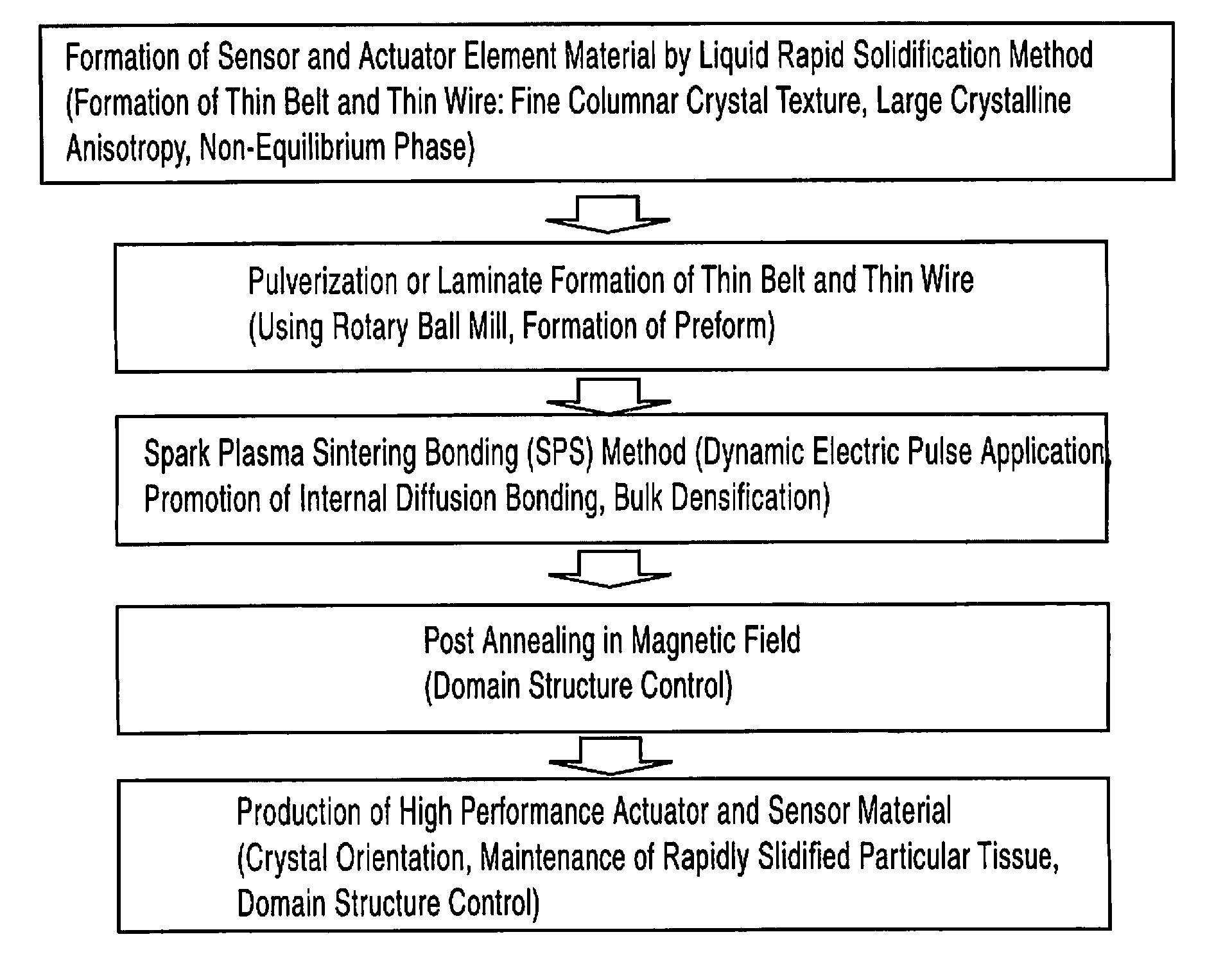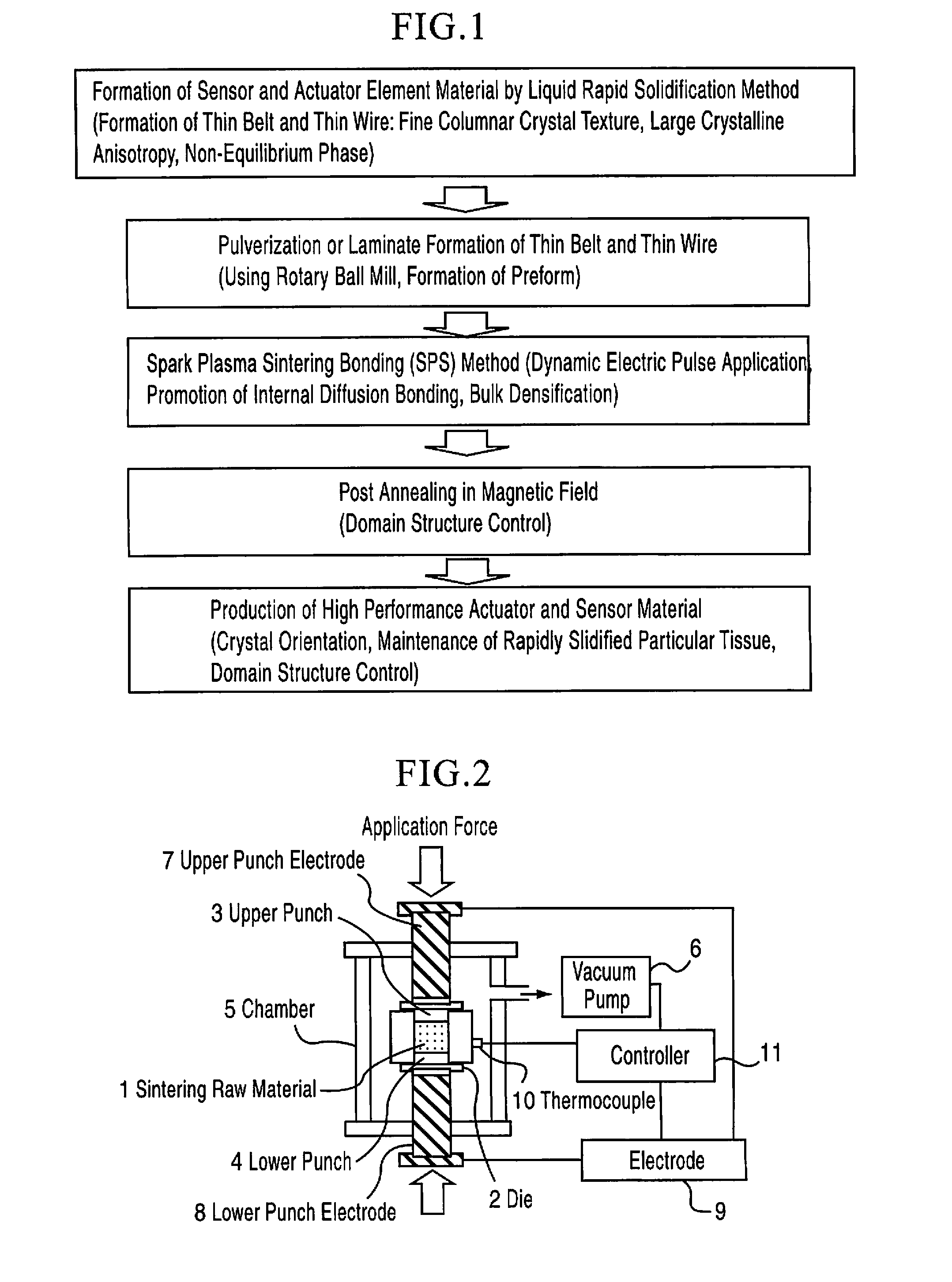Bulk solidified quenched material and process for producing the same
a technology of quenched material and bulk solidification, which is applied in the direction of magnetic materials, magnetic bodies, device material selection, etc., can solve the problems of difficult to obtain a material having predetermined properties by a melt method, and achieve the effect of increasing the energy density of rising strain at the initial magnetization stage, superior workability (ductility), and high rigidity
- Summary
- Abstract
- Description
- Claims
- Application Information
AI Technical Summary
Benefits of technology
Problems solved by technology
Method used
Image
Examples
example 1
[0045] A Fe-17 at % Ga alloy ingot was formed by melting electrolytic iron and Ga by a plasma arc melting method. This ingot was melt and was formed into a thin belt 2 m long, 5 mm wide, and 80 μm thick in an argon atmosphere by a liquid rapid solidification (single roll) method. This thin belt was cut into slices 40 mm long to be used for a discharge plasma sintering sample.
[0046] After 300 slices were stacked together in a cemented carbide alloy die, sintering was performed for Sample (a) under 50 MPa at 973 K, Sample (b) under 100 MPa at 973 K, and Sample (c) under 300 MPa at 873 K, and the sintering time was set to 5 minutes. As a spark plasma sintering apparatus, SPS 1050 manufactured by Sumitomo Coal Mining Co., Ltd. was used. The spark plasma sintering was performed at a vacuum degree of 2 Pa, a current of 3,000 A, and a voltage of 200 V. The temperature rising conditions were different depending on the temperature; however, it was approximately 30 minutes. The size of the s...
example 2
[0052] Sample (b), the sample sintered under 100 MPa at 973 K, produced by the method described in Example 1 was annealed at 1,173 K for 1 hour in a vacuum atmosphere. After the annealing, the magnetostriction was measured. FIG. 7 is a graph showing the magnetostrictions of the sintered sample before and after the annealing. The magnetostrictions before and after the annealing at H of 2 kOe were 100 ppm and 170 to 230 ppm, respectively, and it was found that the magnetostriction was increased by the annealing. Furthermore, when annealing in a magnetic field was performed after the sintering, the magnetostriction was increased to 250 to 260 ppm. The reason the magnetostriction is increased when the thin belt sample is annealed for a short period of time is believed that the [100] orientation is enhanced so that the magnetostriction is increased [see Non-Patent Document 2], and in addition, it is also believed that the magnetic moments (magnetic domain structures) directly relating to...
example 3
[0053] [Example of TiNiCu Shape-Memory Alloy]
[0054] Materials were weighed so as to have a composition of Ti50Ni40Cu10 (atomic percent) and were then formed into alloy ingots as a raw material by a plasma arc melting method in an argon atmosphere. Subsequently, from the ingots thus formed, a thin belt (ribbon) was formed by a high frequency induction melting-liquid rapid solidification method (twin roll quenching method), and a thin wire (fiber) was formed by plasma arc melting-melt extraction rapid solidification method (conical-roll front-end spinning method), so that rapidly solidified materials were obtained. The rapidly solidified materials were wet-pulverized (in ethanol having a purity of 99.99%) by ball milling, so that Example A (ribbon) and Example B (fiber) were obtained. In addition, pulverization was performed in a dry atmosphere (in the air), so that Comparative example A (ribbon) and Comparative example B (fiber) were obtained.
[0055] The DSC change with the milling t...
PUM
| Property | Measurement | Unit |
|---|---|---|
| temperature | aaaaa | aaaaa |
| pressure | aaaaa | aaaaa |
| diameter | aaaaa | aaaaa |
Abstract
Description
Claims
Application Information
 Login to View More
Login to View More - R&D
- Intellectual Property
- Life Sciences
- Materials
- Tech Scout
- Unparalleled Data Quality
- Higher Quality Content
- 60% Fewer Hallucinations
Browse by: Latest US Patents, China's latest patents, Technical Efficacy Thesaurus, Application Domain, Technology Topic, Popular Technical Reports.
© 2025 PatSnap. All rights reserved.Legal|Privacy policy|Modern Slavery Act Transparency Statement|Sitemap|About US| Contact US: help@patsnap.com



